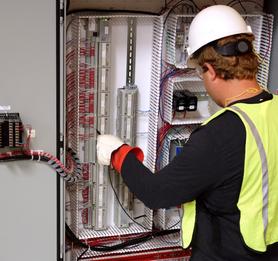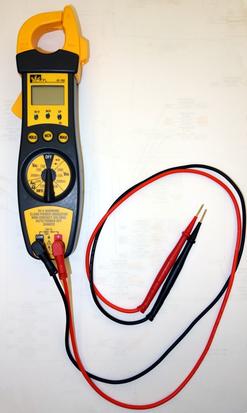We are all aware of the dangers of electric shock, but few realize how little current and how small voltages can cause a fatal shock. Current as low as 30mA can be fatal. Since a standard toaster uses about 12500mA, you can see that the threat of electric shock is ever present. However, using the right tools and safety procedures can greatly reduce this risk.
When working with electrical panels, a “lock out-tag out” procedure is an easy way to quickly reduce hazards and should always be enforced. If possible, de-energize circuits prior to working on or near them. Unfortunately, when working with control panels in a manufacturing facility that is in production, this is not always an option. In this case, wearing the correct protective gear appropriate for the panel rating is very important.
The Importance of Protective Gear
 Wearing flame resistant clothing, removing watches and other jewelry, wearing insulated gloves, safety glasses or a face shield, and using insulated tools are all great protective ware. So, how much and what kinds of protective gear should be worn for each panel rating? The best way to answer this question is to research safety standards and stay up-to-date with the most recent standard releases found in NFPA 70E Article 130.
Wearing flame resistant clothing, removing watches and other jewelry, wearing insulated gloves, safety glasses or a face shield, and using insulated tools are all great protective ware. So, how much and what kinds of protective gear should be worn for each panel rating? The best way to answer this question is to research safety standards and stay up-to-date with the most recent standard releases found in NFPA 70E Article 130.
There are 5 hazard risk categories that require different protective gear (category 0 through category 4). According to NFPA 70E Article 130, a category 0 task will require you to wear long sleeves and long pants of a non-melting material along with safety glasses and hearing protection. Operating a circuit breaker with covers on it would fall into category 0.
Category 1 will require Arc-rated clothing of at least level 4 along with hard hat, safety glasses, hearing protection, insulated leather gloves, leather work shoes and an arc rated face shield. Voltage testing of live circuits under 240 V will fall under a category 1 task. It would also require the use of insulated hand tools. For information about protective gear for other categories, use Article 130 referred to above.
Working with Live Circuits
 Always make sure to visually inspect all tools before using them on a live circuit. Also make sure the meter is correctly rated for the circuit you are testing. Connect the ground lead first then the hot lead. When finished, remove the hot lead first then remove the ground lead. It is also a good idea to hang or rest the meter in a secure location and avoid holding it in your hand in case of a meter fault.
Always make sure to visually inspect all tools before using them on a live circuit. Also make sure the meter is correctly rated for the circuit you are testing. Connect the ground lead first then the hot lead. When finished, remove the hot lead first then remove the ground lead. It is also a good idea to hang or rest the meter in a secure location and avoid holding it in your hand in case of a meter fault.
Communication and Coordination
Communicating and coordinating with the people in your work environment to make the area as safe as possible is essential. Making people aware of the work you are doing in that area. Putting together a plan and discussing it with others on-site is a good way to ensure that everyone is cognizant of what is happening. You have to think about everyone that could come in contact with the work being performed. Use orange cones and caution tape to guide people away from hazardous work zones.
Safety is one of the most important issues of working with electricity on any site. A little planning and attention to safety during implementation is all it takes to make a safe work environment.

